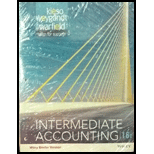
Concept explainers
Introduction:
(a) To determine: To determine whether the below entry would be recorded in statement of cash flow. Then how and also where in the cash flow they would be recorded.
Given Information:
- Cost of plant: $20,000
- Straight-line
depreciation followed - No scrap value at end of life
(b) To determine: To determine where to record issuance of common stock.
(c) To determine: To determine whether debts affects the cash flow statement.
(d) To compute: To compute cash flows (Financing and Operating activities).
Given Information:
- Net loss: $50,000
- Depreciation: $22,000
- Gain realized: $9,000
- Sale of land: $39,000
(e) To determine: To determine whether the bill is included in the statement.
Given Information: Treasury bill purchased: $100,000.
(f) To determine: To determine whether to add plant amortization.
Given Information: Patent amortization: $20,000.
(g) To determine: To determine where will the given entry be shown.
Given Information: Common stock for exchanged for 70% interest in T Co. for $900,000.
(h) To determine: To determine where will the given entry be shown.
Given Information: Purchased
Want to see the full answer?
Check out a sample textbook solution
Chapter 23 Solutions
Intermediate Accounting 16E Binder Ready Version With Wiley Plus Blackboard
- Mona reported $70,000 in net profit for the year using absorption costing. The company had no units in beginning inventory, planned and actual production was 21,500 units and sales were 19,000 units during the year. Variable manufacturing costs were $20 per unit and total budgeted fixed manufacturing overhead was $100,000. There was no underapplied or overapplied overhead reported during the year. Determine the net profit under variable costing.arrow_forwardPlease give me true answer this financial accounting questionarrow_forwardNonearrow_forward
- Solve this Accounting problemarrow_forwardDover Chemical Company manufactures specialty chemicals by a series of three processes, all materials being introduced in the Distilling Department. From the Distilling Department, the materials pass through the Reaction and Filling departments, emerging as finished chemicals. The balance in the account Work in Process—Filling was as follows on January 1: Work in Process—Filling Department(2,700 units, 30% completed): Line Item Description Amount Direct materials (2,700 × $15.80) $42,660 Conversion (2,700 × 30% × $10.30) 8,343 Total $51,003 The following costs were charged to Work in Process—Filling during January: Direct materials transferred from Reaction Line Item Description Amount Department: 34,800 units at $15.60 a unit $542,880 Direct labor 198,580 Factory overhead 190,793 During January, 34,500 units of specialty chemicals were completed. Work in Process—Filling Department on January 31 was 3,000 units, 90% completed.arrow_forwardneed true answer General accounting questionarrow_forward

 AccountingAccountingISBN:9781337272094Author:WARREN, Carl S., Reeve, James M., Duchac, Jonathan E.Publisher:Cengage Learning,
AccountingAccountingISBN:9781337272094Author:WARREN, Carl S., Reeve, James M., Duchac, Jonathan E.Publisher:Cengage Learning, Accounting Information SystemsAccountingISBN:9781337619202Author:Hall, James A.Publisher:Cengage Learning,
Accounting Information SystemsAccountingISBN:9781337619202Author:Hall, James A.Publisher:Cengage Learning, Horngren's Cost Accounting: A Managerial Emphasis...AccountingISBN:9780134475585Author:Srikant M. Datar, Madhav V. RajanPublisher:PEARSON
Horngren's Cost Accounting: A Managerial Emphasis...AccountingISBN:9780134475585Author:Srikant M. Datar, Madhav V. RajanPublisher:PEARSON Intermediate AccountingAccountingISBN:9781259722660Author:J. David Spiceland, Mark W. Nelson, Wayne M ThomasPublisher:McGraw-Hill Education
Intermediate AccountingAccountingISBN:9781259722660Author:J. David Spiceland, Mark W. Nelson, Wayne M ThomasPublisher:McGraw-Hill Education Financial and Managerial AccountingAccountingISBN:9781259726705Author:John J Wild, Ken W. Shaw, Barbara Chiappetta Fundamental Accounting PrinciplesPublisher:McGraw-Hill Education
Financial and Managerial AccountingAccountingISBN:9781259726705Author:John J Wild, Ken W. Shaw, Barbara Chiappetta Fundamental Accounting PrinciplesPublisher:McGraw-Hill Education





